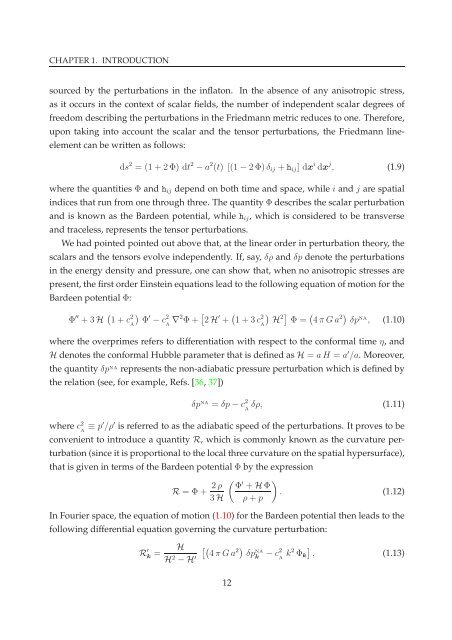PHYS08200605006 D.K. Hazra - Homi Bhabha National Institute
PHYS08200605006 D.K. Hazra - Homi Bhabha National Institute
PHYS08200605006 D.K. Hazra - Homi Bhabha National Institute
Create successful ePaper yourself
Turn your PDF publications into a flip-book with our unique Google optimized e-Paper software.
CHAPTER 1. INTRODUCTION<br />
sourced by the perturbations in the inflaton. In the absence of any anisotropic stress,<br />
as it occurs in the context of scalar fields, the number of independent scalar degrees of<br />
freedom describing the perturbations in the Friedmann metric reduces to one. Therefore,<br />
upon taking into account the scalar and the tensor perturbations, the Friedmann lineelement<br />
can be written as follows:<br />
ds 2 = (1+2Φ) dt 2 −a 2 (t) [(1−2Φ)δ ij +h ij ] dx i dx j , (1.9)<br />
where the quantities Φ and h ij depend on both time and space, while i and j are spatial<br />
indices that run from one through three. The quantityΦdescribes the scalar perturbation<br />
and is known as the Bardeen potential, while h ij , which is considered to be transverse<br />
and traceless, represents the tensor perturbations.<br />
We had pointed pointed out above that, at the linear order in perturbation theory, the<br />
scalars and the tensors evolve independently. If, say, δρ and δp denote the perturbations<br />
in the energy density and pressure, one can show that, when no anisotropic stresses are<br />
present, the first order Einstein equations lead to the following equation of motion for the<br />
Bardeen potential Φ:<br />
Φ ′′ +3H ( 1+c 2 A)<br />
Φ ′ −c 2 A ∇2 Φ+ [ 2H ′ + ( 1+3c 2 A)<br />
H<br />
2 ] Φ = ( 4πGa 2) δp NA , (1.10)<br />
where the overprimes refers to differentiation with respect to the conformal time η, and<br />
H denotes the conformal Hubble parameter that is defined asH = aH = a ′ /a. Moreover,<br />
the quantity δp NA represents the non-adiabatic pressure perturbation which is defined by<br />
the relation (see, for example, Refs. [36, 37])<br />
δp NA = δp−c 2 δρ, (1.11)<br />
A<br />
where c 2 A ≡ p′ /ρ ′ is referred to as the adiabatic speed of the perturbations. It proves to be<br />
convenient to introduce a quantity R, which is commonly known as the curvature perturbation<br />
(since it is proportional to the local three curvature on the spatial hypersurface),<br />
that is given in terms of the Bardeen potential Φ by the expression<br />
R = Φ+ 2ρ ( ) Φ ′ +HΦ<br />
. (1.12)<br />
3H ρ+p<br />
In Fourier space, the equation of motion (1.10) for the Bardeen potential then leads to the<br />
following differential equation governing the curvature perturbation:<br />
R ′ k =<br />
H<br />
H 2 −H ′ [(<br />
4πGa<br />
2 ) δp NA<br />
k −c2 A k2 Φ k<br />
]<br />
, (1.13)<br />
12
















